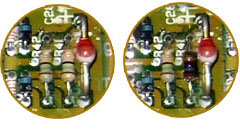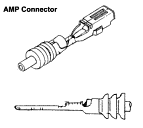|
|
||||||||||||||||||||||||||||||||||||||||||||||||||||||||||
Statistics
|
|
|||||||||||||||||||||||||||
Overview
The purpose and function of the transmission -The Honda Automatic transmission is designed to allow the engine run in a favorable speed range in spite of varying acceleration and terrain. The Automatic transmission also allows the wheel to grip bad, loose or slippery roads, to provide engine braking and to protect the motor from excessive lugging.
The 90-93 Accord is a modern vehicle that relies on the computer to determine shifting points to increase comfort and safety. Without the computer the transmission won't shift and the car will simply move at a snail's pace or will simply default to limp mode, which can either be 2nd, 3rd or 4th gear. For example, a faulty transmission computer could cause the car to suddenly shift into lower gear while driving. This causes the car to drop in speed while the RPM shoots up. With other cases, the car will have a hard time accelerating from a stop unless the car is first manually shift to D2. The symptoms are followed by the 'S' or 'D4' shifter status light on the instrument panel blinking, or lights up or doesn't light up at all.
If the car won't shift into correct gears and displays a self-diagnostic light most likely the fault is not with the transmission. Sometimes a clattering sound may also be heard in the cockpit. This may be the sound of the transmission interlock system misbehaving, which may indicate a bad TCU.
Do not replace the transmission without first confirming the situation electronically. The fault is usually the Automatic Transmission Control Unit (also known as the automatic transmission computer or TCU/TCM.)
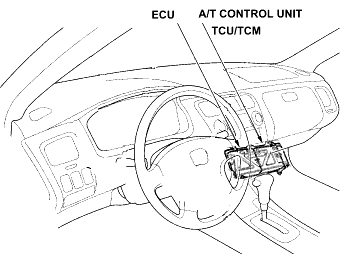
Proper operation: The car starts at first gear at half throttle.
- When the speed reaches about 17 - 21-mph the car shifts to second gear.
- When the speed reaches about 35 - 39-mph shifts to third gear.
- When the speed reaches about 54 - 60-mph the car shifts to fourth gear.
- When the speed reaches 60 - 65-mph or more the lock up torque converter engages. This is felt as a slight nudge. Shift sequence ends.
- The rpm may range from 2000 - 5000 before shifting depending on the throttle position. The 90-93 Accord can stay up to 68-mph in second gear.
If there is a problem with the input or output in the A/T control unit the D4 or S light in the gauge assembly will blink. However, some PGM-FI problem will also make the D4 light in the gauge assembly blink. If there is a problem with the emission fuel control system the code will have to be retrieved from the check engine light first. Repairing the emission fuel control system is first priority. After repairing the PGM-FI system then reset the A/T unit's memory.
Problem: The usual problem with the Honda Accord transmission, namely the 90,91, -, - Accord, is a bad transmission computer. What happens is that the transmission computer has a couple cheap parts that fail. The failing parts may or may not automatically put the TCU into a saftey (limp) mode (aka, the "fail safe strategy.") The three known failed components are two resistors and a capacitor inside the transmission computer. The symptoms are of several types. The car "S" light or "D4" is on (just stays on D4 no matter what gear is selected) or blinking and the transmission won't shift into any gears or sometimes stuck on a certain gear. The trouble codes could be 1,2,7,8,9,15 or None. Shifter interlock control unit buzzes. When the driver steps on the gas the rpm goes high but the car refuses to move at the expected speed. By resetting the TCU, either by removing the fuse for a certain period or by disconnecting the negative battery for 5 to 10 seconds will eliminate the problem, but only temporarily.
TCU/TCM Fix
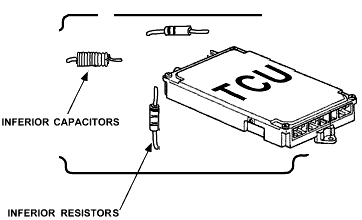
The resistors R41, R42, R43, are overheated or burned and capacitors C27, C28, C32, C33, C5 leaking or shorted. Some resistors will be burned off to the point where no one can determine the values. A common sense approach is to consult a working TCU and read the color code on the resistors or start with the highest resistance and go down. Find the best wattage resistor or the best voltage capacitor that can fit.
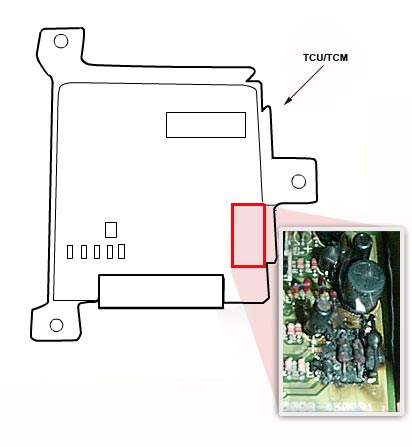
The problem originates with the electrolytic capacitors leaking. Often, the capacitor short circuits frying other components such as your resistor. Another words, the burned resistor is a result of another component failure, namely the capacitor. The fix is to replace the bad parts. See the values below.
Parts values: R41 is most likely 15 Ohms; R42 is 15 Ohms, both appears to look like a 1/4 to 1/2 Watt;
Capacitor C28 105`C 220uF 35V Nichicon
H9146. Replace all of them or else the problem may return. If the problem returns, it's likely not your solenoids, but the parts on the circuit board.
sample: Before it was new and now it has fried.
Maintenance Schedule Info: For the first, second and third generation Accords.
Replace the transmission fluid every 30,000 miles or every two years, which ever comes first, using DEXTRON II ATF Premium Formula ATF (2.5quarts). Under harsh conditions the ATF is service twice as often. All are a recommendation of the service manual. Harsh conditions are classified as towing, stop and go traffic, extreme climates, and extreme hill climbing.
The Honda ATF-Z1 is recommended as source for premium fluid with smoother
shift and specifically design for certain components inside the
transmission. Sold only at dealers or from websites. Search for "ATF-Z1" or "08200-9001"
Current price comparison: DEXTRON II,III ATF is 3.3USD per quart, Honda
ATF-Z1 is 5.176USD per quart. A complete fluid overhaul would require about 10
quarts or more. (A simple drain and refill, maybe about 2-1/2 to 4 quarts.)
Author recommends ATF-Z1 to protect from harsh shifting in the future: I believe it may be possible that the generic aftermarket ATF can cause the clutch to change in a negative way (often permanently) when the owner uses the generic aftermarket ATF. The symptom is a harsh shifting that many people have been complaining about. And when the owner begins to change back to using the genuine ATF the harsh shift only improves very little and the harsh shift doesn't go away. After switching to the ATF-Z1, only time will tell as the genuine fluid begin to leach into the clutch and replaces itself with the new ATF-Z1 completely. If the generic ATF is truely a real problem then Hondas are pretty picky about fluids, just as the power steering is also picky about its power steering fluid.
Won't shift and no "D4" or "S-light":
The electronic solenoid valve will likely need to be removed and cleaned if there are no diagnostic light and the transmission shows the symptoms above. The solenoids may be restricted with metal particles or debris causing shift malfunctions. The old fluid should then be removed and inspected for dark color and debris then replaced with a Honda ATF (using the recommended fluid or the Honda ATF-Z1.) This section will hopefully point you to a TCU, thermostat, TW sensor or a valve body or a solenoid problem.
If there are no diagnostic light and the car doesn't move on the right gears or does not shift into first, second, third, fourth or reverse gear, inspect the two Shift Control Solenoid Valve (A,B) (location 2) which is located a feet below the two Lock Up Control Solenoid Valve (A,B) (location 1) in the circled areas on the image above, near the bottom of the radiator.

The solenoid assembly can be removed with a ratchet and a 10mm socket and
the inlet and outlet of the assembly cleaned with a carburetor cleaner while engaging the solenoid with a
battery. The gasket can cleaned with soap and water (DO NOT SOAK in solvent cleaners)
and be reused but you should check
for leaks after having shifted thru all the gears and have test driven.
![]() Troubleshooting:
Connecting the battery to the solenoid test. The
solenoid produces a click when battery voltage is applied to the terminal 1 and/or
2 while the solenoids are still attached to the transmission. The same click should occur under fluid pressure. If they don't
work under pressure then they need
replacing.
Troubleshooting:
Connecting the battery to the solenoid test. The
solenoid produces a click when battery voltage is applied to the terminal 1 and/or
2 while the solenoids are still attached to the transmission. The same click should occur under fluid pressure. If they don't
work under pressure then they need
replacing.
![]() Troubleshooting:
Wiring. To
troubleshoot the solenoid wirings see Troubleshooting: Proper operation and check
whether the solenoids are clicking okay. If not, then the proper way to check for a faulty
wiring is to check for the solenoid resistance at the TCU harness and ground.
How to do this? Read the wire color on the solenoid. Go to and disconnect the TCU
wire harness at the TCU. Locate that wire color. Measure for the resistance to
ground. The resistance should show (correction:) 12-24 Ohms.
Troubleshooting:
Wiring. To
troubleshoot the solenoid wirings see Troubleshooting: Proper operation and check
whether the solenoids are clicking okay. If not, then the proper way to check for a faulty
wiring is to check for the solenoid resistance at the TCU harness and ground.
How to do this? Read the wire color on the solenoid. Go to and disconnect the TCU
wire harness at the TCU. Locate that wire color. Measure for the resistance to
ground. The resistance should show (correction:) 12-24 Ohms.
![]() Troubleshooting:
Resistance test. Measure the solenoid's resistance using an Ohmmeter. Their resistance should
be between 12 to 24 Ohms. If their resistance are not within the spec then they need
replacing.
Troubleshooting:
Resistance test. Measure the solenoid's resistance using an Ohmmeter. Their resistance should
be between 12 to 24 Ohms. If their resistance are not within the spec then they need
replacing.
![]() Troubleshooting:
Thermostat. If
the thermostat temperature is too low the car will refuse to shift because the
temperature sensor (TW sensor) tells the TCU not to shift on a cold motor. To troubleshoot,
try a hotter temperature thermostat, check the resistance of the TW sensor or check for low coolant.
Troubleshooting:
Thermostat. If
the thermostat temperature is too low the car will refuse to shift because the
temperature sensor (TW sensor) tells the TCU not to shift on a cold motor. To troubleshoot,
try a hotter temperature thermostat, check the resistance of the TW sensor or check for low coolant.
![]() Troubleshooting:
Proper operation. Warm up the transmission after a drive and put the car
into reverse and you should hear or feel a click on one of the Shift Control
Solenoid Valve. Put the car in neutral will feel another click. Put it in D and another click is
heard or felt, except it will be felt on the other shift solenoid.
Use a mechanic's stethoscope.
Troubleshooting:
Proper operation. Warm up the transmission after a drive and put the car
into reverse and you should hear or feel a click on one of the Shift Control
Solenoid Valve. Put the car in neutral will feel another click. Put it in D and another click is
heard or felt, except it will be felt on the other shift solenoid.
Use a mechanic's stethoscope.
The activation of the solenoid is triggered after receiving signals from each sensor fed into the TCU. A disconnected TCU will still allow the car to move but will do so in 4th gear.
![]() Troubleshooting: Checking
the solenoid
and TCU for proper function.
Troubleshooting: Checking
the solenoid
and TCU for proper function.
Tip: The proper way to test the solenoid function is to do a pressure drop test on the selected solenoid pressure ports (see "Troubleshooting the solenoid and the modulator fluid pressure" several paragraphs below.)
To troubleshoot, a current measurement can be taken. What this does is attach an ammeter at the solenoid connector and observe the reading for trouble. If there are no ammeter a test light is fine if you just want to know if the TCU is putting out the right power to the solenoids at the right time. The driving test results should point to a malfunctioning TCU, or PGM-FI problem based on how the gear engages and the activity on the ammeter. It can even point you to an external problem such as a bad thermostat or a low coolant level. Look for the following when operating the ammeter:
- The gear should shift when the reading in the ammeter or the test lights comes on.
- To find out when the readings is expected to come on, see below:
1. How the second gear engages: The second gear engages when solenoid B is on and solenoid A is on. When the solenoid is off fluid is restricted from flowing back into the oil (fluid) pan.
2. How the third gear engages: The third gear engages when solenoid B is off but the solenoid A is on. This engages the 2-3 shift valve, thereby supplying the third clutch with pressure.
A troubleshooting tool called an AMP connector (left.) (Right) the ammeter on the solenoid helps determine whether the TCU is providing the right current at every shift stage which may help locate an intermittent faulty TCU or a faulty solenoid circuit. A test light can be used in their place.
The solenoid must be able to restrict the flow of fluid when it is off. If the solenoid is old or dirty it may not have the ability to stop fluid, therefore may not have the capacity to control the 2-3 shift valve correctly, in this case slipping on 3rd and sometimes fourth. But keep in mind that if there are debris suspended in the fluid the debris may clog the 2-3 shift valve or the modulator valve causing the same symptoms.
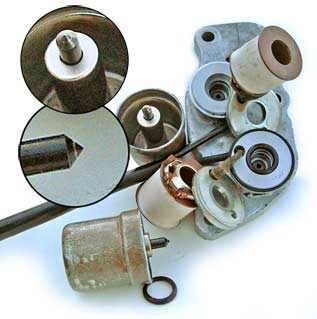 Enlarge
EnlargeShift solenoid valve Honda Accord 4 Cylinder 1990-1997, Honda Odyssey 1995-1997, Honda Prelude 1992-1997 Notice that the pintle tips are slightly worn, but [not] (edit 3-19-07) enough to be a concern. The job of the pintle is to block or pass the fluid under pressure and/or in motion.
Other possible scenarios: The modulator valve (which hydraulically feeds the solenoids) may be stuck open, flooding the solenoids with more fluid than they can exhaust. The solenoids may also be restricted with metal particles. The symptoms are erratic shifts, no kickdown, wrong gear starts, early shifts, skips second on medium to full throttle, or skips 3rd. To troubleshoot, follow the test below.
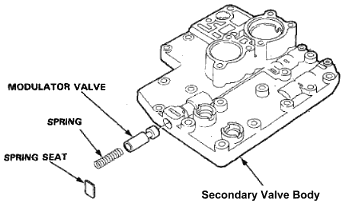
Secondary valve body: The secondary valve body is located inside the transmission. The modulator valve maintains line pressure for the shift and lockup solenoid valves.
![]() Troubleshooting
the solenoid and the modulator fluid pressure:
Troubleshooting
the solenoid and the modulator fluid pressure:
Step 1. Attach a 0-100 psi pressure gauge to shift solenoid A and B for the modulator pressure ports. Place shift lever in park and start the engine. Check the pressure on both parts. It should be 70-95 psi. If it is over 95 psi the modulator valve is stuck.

Line pressure testing: Remove the bolt and attach a pressure gauge. The modulator valve maintains line pressure from the regulator, to the pressure to shift control solenoid valves.
If there is no pressure or low pressure at the line pressure port then the ATF strainer is clogged, the pressure regulator is stuck or oil pump worn or binding.
Step 2. With the engine running connect one end of a jumper lead to the positive terminal of the battery and the other end to BOTH solenoid terminals in the connector. The pressure should drop quickly to under 6 psi. If the pressure is above 6 psi or drops slowly, replace the shift solenoids. See Acura, Honda TSB # 226 for details.
![]() Visual Troubleshooting: Checking
fluid level.
Visual Troubleshooting: Checking
fluid level.
Check the fluid level with the engine at normal operating temperature and parked on a level ground. Shut off the engine then remove the dipstick (yellow loop) from the transmission and wipe it with a clean cloth and insert the dipstick all the way down but don't screw in. The fluid level should be between the lower and upper marks.
![]() Visual Troubleshooting: Checking
fluid condition.
Visual Troubleshooting: Checking
fluid condition.
Drain the fluid and inspect the fluid color or for any small suspended particles. Inspect the magnetic pickup on the drain bolt. If there are suspended particles and the magnet has picked up more debris than it can hold then there could be an internal seized valve problem. If there are debris or the fluid color is black then the old fluid should be removed and replaced.
How to remove the 92-93 (or 90-91) Accord automatic transmission.
Ratchet, a 17mm deep hexagon, a normal 10mm, 12mm, and 14mm sockets. Socket extension, 10mm box wrench. Large flat head screw driver. A punch and a hammer. A transmission jack or several jacks, a 120-lb hoist.
Steps:
- Remove the hub cap but put the tire and nuts back in.
- Punch out the spindle nut lock and loosen the spindle nut.
- Raise and support the vehicle and block the tires.
- Drain the transmission.
- Remove the all the damper fork nuts and all the brake hose nuts on the damper fork and the on the shock absorber.
- Remove the damper fork.
- Remove the driver side and passenger side front suspension flange nut inside the engine bay and slide the upper arm out.
- Read more...

Troubleshooting:
Troubleshooting: On this page are several
troubleshooting icons ![]() .
Run the troubleshooting steps that most likely fit your issues. The
diagnostic trouble codes can be retrieved. Retrieving the diagnostic trouble codes by
jumping the two terminals connector (blue) and count the number of flashing codes on
your instrument gauge.
.
Run the troubleshooting steps that most likely fit your issues. The
diagnostic trouble codes can be retrieved. Retrieving the diagnostic trouble codes by
jumping the two terminals connector (blue) and count the number of flashing codes on
your instrument gauge.
-
Make sure that the 'S' or 'D4' shifter status light on the instrument panel lights up for at least two seconds, or blinks after the key is turned on.
-
Turn the key off.
-
Jump the two 'Service Check Connector ' A, B pins together and turn the key to ON (II.)
-
Watch the 'S' or 'D4' light for flashes.
If no problem exists, the light won't flash. If a problem exists, the light will give you either short, or long and short flashes. Short flashes are a 'ones' digit of either a one or a two digit trouble code. Long flashes are the 'tens' digit of a two digit code. Short flashes are about a half second long, and long flashes last about a second and a half. There is about a one second 'OFF' pause between each code.
All codes will be shown in sequence, lowest number first, up to the highest number. The sequence will repeat as long as the key is on and the connector is jumped together." †
-
Turn the key off. Remove the two AMP male connectors (or jump tool) from the 'Service Check Connector ' pins.

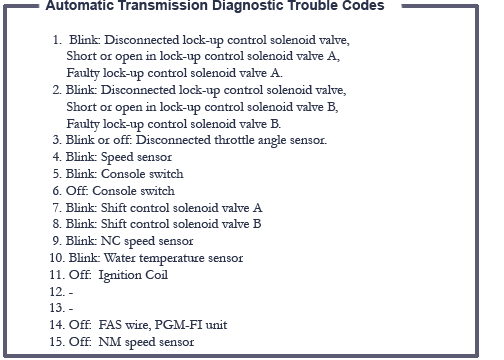
*Different models use different codes: The differences are listed
below:
13. Main shaft speed pulse generator
open or shorted.
14. Linear (line pressure control) solenoid open or shorted.
15. Kickdown switch circuit shorted.

92 Accord ECU Fuse (7.5A) Reset Location
NC/NM speed sensor, code 9/15
Symptoms of a faulty NM speed sensor: Located at the end (passenger side) of the transmission on some models, check for code 15 or transmission jerks hard when shifting. Symptoms of a faulty NC speed sensor is the lock-up clutch does not engage. The NM or NC speed sensor (code 9) should be within 400-600 Ohms at 20-degrees C. If they are not within spec replace them. If they are within spec check for a possible short to ground but first unplug the harnesses at the TCU.

How to replace the NC speed sensor:
-
To locate the NC speed sensor on the back of the transmission follow two wires connected to the sensor. The sensor is located on the transmission between the engine firewall and the transmission towards the tire's mud guard on the 90-93 Accord. The NC speed sensor appears to look like a fuel injector (not the best of description.)
-
Reach inside with a 10 mm socket wrench and unbolt 1 bolt that holds the speed sensor in place.
-
Carefully twist the speed sensor as you pull it out.
-
Replace the O-ring.
How to replace the NM speed sensor:
-
To locate the NM speed sensor on the front of the transmission follow two wires connected to the sensor. The sensor is located on the transmission between the engine radiator and the transmission towards the tire's mud guard on the 90-93 Accord. The NC speed sensor appears to look like a fuel injector (not the best of description.)
-
Reach inside with a 10 mm socket wrench and unbolt 1 bolt that holds the speed sensor in place.
-
Carefully twist the speed sensor as you pull it out.
-
Replace the O-ring.
Author's tip on the NM/NC sensors: Usually, these sensors can pick up a lot of metal particles or metal dusts which can magnetically pile on top of the sensor surroundings. On some vehicle, the control unit simply won't function properly and the car can jerk harshly. On these cases, I simply remove the sensor then wipe and wash out the metal debris and reinstall. I then reset the computer. Everything would work as it should. The buildup of materials simply won't let the sensor read.
Solutions 1 and 2
Solution 1:
The solution is to replace the TCU/TCM (Automatic Transmission Control Unit, aka Automatic Transmission Control Module) or see the tutorial on how to replace the blown resistors and the capacitors with a better value if the symptoms points to a TCU problem. Replacing the TCU with the same model number may blow the same circuit or component inside the TCU unless a corrected TCU is purchased.
The improved TCU is the one you should install in your vehicle. We don't have the part number data on all the improved TCU. Please contact your local dealer and obtain the Honda Technical Service Bulletin to find out which part is meant for your car.
Solution 2:
-
If there are no diagnostic trouble codes, most likely the shift valve solenoid is stuck, weak or needs cleaning or replacement (as outlined above.)
-
If there are no diagnostic trouble codes and the line pressure confirms so, then a valve body is stuck.
-
On some vehicles, replacing the main relay will also solve the "won't shift and blinking D4 light" problem. See bottom of page.
| TCU PARTS INFORMATION |
||
| Built Location | Automatic Transmission Control Unit (Redesigned) Part Number for 90 Accord | |
| Japan-built EX: | P/N 28100-PX4-932 | H/C 3523933 |
| Japan-built LX & DX: | P/N 28100-PX4-922 | H/C 3520269 |
| US-built EX: | P/N 28100-PX0-932 | H/C 3521796 |
| US-built LX & DX: | P/N 28100-PX0-922 | H/C 3521788 |
How to replace the TCM/TCU:
Steps (edit 3-30-07):
- Locate the passenger foot rest carpet and peel it back. If there is a
clip, pry them out.

- Remove the large steel cover bolts using a 10-mm deep socket wrench with extension.
- Disconnect the harness connector by inserting a flat head screw driver and
unlock the clip and slide the harness connector outward.
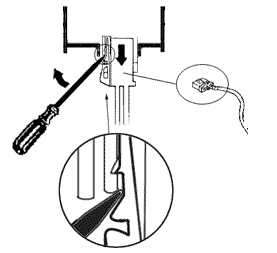
You can also press the tab on the connector by hand and pull the harness straight out. Do not pull on the wires.
- If there are bolts holding the ECU, remove them in order to remove the TCU. The TCU/TCM is the one on the right.
- Remove the bolts holding the TCU.
- Open the TCU with a phillips screw driver and inspect for sign of burned or leaking
parts.

Tip: The second generation Acura Legend TCU is also located in this area. The TCU box is marked "A/T."
Other problem/solution
Problem: My car won't automatically shift into third but the car always work normally when I shut the engine off. What is causing it?
Probable Solution: Fix the electrical problem or the transmission, or replace the fluid.
![]() To
find out if the cause is from the electronics shut off all the electronics,
including the ECU while coasting in gear for 5 seconds. How is this done?
Bring the car up to 50-mph in D3 and release the gas. Turn off the ignition
(DO NOT remove the key.) When the rpm decreases and reaches 1300-rpm switch
the ignition to ON. If the shift problem persist then the problem is inside the
transmission. If the problems goes away for a while (but only after disconnecting the
battery) then the TCU is most likely at fault.
To
find out if the cause is from the electronics shut off all the electronics,
including the ECU while coasting in gear for 5 seconds. How is this done?
Bring the car up to 50-mph in D3 and release the gas. Turn off the ignition
(DO NOT remove the key.) When the rpm decreases and reaches 1300-rpm switch
the ignition to ON. If the shift problem persist then the problem is inside the
transmission. If the problems goes away for a while (but only after disconnecting the
battery) then the TCU is most likely at fault.
Problem: My car shifts harshly... when it shifts it jerks, a bad shift shock. What is causing it and how do I fix it?
Only for the computer controlled transmission. The transmission detects pedal dept via two points. One at the TPS and the other at the transmission. If the deeper you press the gas the less harsh it becomes then the problems lies on the out-of-adjustment at the transmission throttle cable.
Probable solution: Using a wrench, adjust the transmission throttle cable in small increments and test drive. Tip: The more the slack the harsher the shift. If this does not solve the problem then it could be a shift timing or other problems as expressed below.
Extra thoughts from the author about harsh shifting: The harsh shifting found on these electronic transmission is notorious. Where is the problem coming from? From speculation, it could be coming from the clutch (which could have been damage from using generic ATF.) Or the problem could be coming the TCU. The TCU, which in effect is fed data from sensors (such as the transmission NM/NC speed sensor) throughout the transmission and the engine. The sensors tell the TCU when to shift at the correct moment. If any of these moments are off a bit due to bad sensors readings then they could produce a jerk as it shifts. Such as we don't normally shift when we are at the wrong rpm, car speed or gear. Doing so will produce a harsh embarrassing shift. Back in the days of the mechanical shifting, none of these problem occur. The current problem is that there are too many sensors and some of them could be failing to work correctly and the TCU is blinded by their conditions. The TCU is often only acting on bad advice. Troubleshooting may require the car hooking up to a computer for analysis making sure the sensors are working as they should. Many of you don't have access to these sophisticated system. So, the best advice is to remove each sensor, clean them and test them using a multimeter and put them back in and test drive. And repeat the procedure for other sensors. The software could be rewritten to fix its behavior but is not solving the problem. The internal parts of the transmission itself may be misbehaving. Inside the transmission is a clutch fluid shock absorber which is somewhat controlled by the throttle pedal. This absorber may not be of any usefulness if the clutch is already possibly damage from using the wrong AT fluid. Replacing with a new good transmission may be the best bet in trying to solve it. Your luck will be needed since people often will put various kinds of random fluid in there. The harsh shifting problems isn't mission critical that is why we cannot expand the topic further. Added June-10-09, last edit on Sept-12-10
Problem: My car [electronic controlled transmission] won't automatically shift into third and there is a check engine light or sometimes no check engine light. What is causing it?
Solution: Fix the engine problem. Remember, a weak engine due to ignition or PGM-FI problems will not allow the vehicle to shift to third or fourth nor does a faulty TPS, shift solenoid, thermostat or coolant temp sensor.
Problem: My car won't shift into fourth and there is smoke in tailpipe. What is causing it?
Probable solution: Timing is off on vehicles with twin cams.
Problem: My car won't automatically shift into second (non computerized only.) What is causing it?
Probable solution: Possible shift valve seized. Rebuild required. (effectively, a rebuild simply requires sanding the shift valve.)
Problem: My car won't go in reverse (can't backup.) What is causing it?
Probable solutions: On a car without an electronic transmission, replace fourth gear selector or the affected gear(s). The reverse gear is activated by fluid pressure. Check for an internal clogged fluid. Cars with electronic transmission don't require the shift solenoid to go in reverse.
Problem: Cannot remove the key even in park. What is causing it?
Probable solutions: Make sure the P light is on. See key stuck at ignitionswitch.html#stuck for details.
Problem: My car won't start in park. The starter will not engage (no sound, nothing - except a main relay click) but all other electrical such as headlights are working fine.
Probable solutions: If the car starts only when the P indicator come on or when the car is on neutral then clean or adjust the console switch located on the shift selector (next to your seat.) For the manual transmission, clean, inspect or replace the clutch switch (or the starter relay on some models.) If there are any alarm starter disrupt, bypass them sufficiently to allow maximum current to flow.
Problem: My 90-94 Accord (and some Acura Integra) takes off real slow and won't shift properly, usually happens with a no start. The "S" (D4) light is also blinking, can this caused by the main relay?
Yes. This can happen when the ignition is ON and the ECU/TCU power supply from the main relay drops out momentarily. This could happen in conjunction with a no start condition. The symptoms will usually cause the transmission to shift into the wrong gears (such as 4th.) Instead of 1st, they take off in 2nd, 3rd or 4th gear. This can happen for several different reasons, caused by either internal transmission problems, or external control system problems. External control systems can also cause wrong gear starts. Here are two common external causes:
1. No Power: a complete loss of power or ground to the control system.
2. Fail Safe Strategy: a fail safe protection strategy initiated by the computer to protect itself or the
transmission from an observed problem.
If you have the conditions above, you are probably looking for an electrical problem. If you don't have the symptoms above, you probably have a valve body or solenoid problem.
![]() Probable solution: The solution is to replace or desolder and solder your main relay
(using the best possible method) and check your ignition switch and the culprit
clattering relay. To fix the main relay see Main
Relay Fix to find the Honda accord main relay location see mainrelaydefine.html. If the intermittent problem persist, there could be an
intermittent TCU external power supply problem, or other problems.
Check all power supply inputs to the TCU. The TCU power supply ports should come
on at the same time as the ECU power ports.
Probable solution: The solution is to replace or desolder and solder your main relay
(using the best possible method) and check your ignition switch and the culprit
clattering relay. To fix the main relay see Main
Relay Fix to find the Honda accord main relay location see mainrelaydefine.html. If the intermittent problem persist, there could be an
intermittent TCU external power supply problem, or other problems.
Check all power supply inputs to the TCU. The TCU power supply ports should come
on at the same time as the ECU power ports.
An interesting personal experience from a reader.
Problem:
Stuck on 1st gear. Will only go into 2nd after manipulating
the gear selector.
Solution: Bad TPS
My name is Jerry and I am an Electrical Engineer by trade and a very avid DIY'er on my vehicles.
I have a 1991 Honda Accord that I bought for my daughter and it developed transmission shift problems.
It was displaying no trouble codes but had very similar symptoms to a bad TCU.
SYMPTOMS:
Starting off in D4, the car would stay in 1st gear, not shifting.
Starting off in L1, then manually shifting to L2 the car would shift into 2nd but manually shifting to D3 and D4, the car would just stay in 2nd gear.
I searched the web for advice, found no real help although I did find about a dozen cases just like mine where people were asking for help...no answers found.
Your web site being the only help, I followed your troubleshooting steps and found them very thorough.
REPAIRS:
Unable to find the real problem, and out of frustration, I replaced the caps in my TCU...just for safety. NO FIX
I then, borrowed a factory service manual from a friend (a 13yr experienced Honda dealership mechanic) and started troubleshooting this tough dog. He, by the way, had never seen this particular problem, "that was not caused by either the shift solenoids or a faulty TCU)
Focusing now on the solenoids, I attached a voltmeter to each solenoid wire to test for voltage. Using the factory manual's truth table, I determined that each solenoid was working...just not being told to go to the next state to shift to 3rd gear.
I removed all 3 speed sensors, tested individually, all OK
I then bought a used TCU, $60, thinking that it must have some internal issue with inputs.
NO FIX
Then, going on my friend's suggestion, against my own opinion, I bought new solenoids for $200. The logic seemed sound at the time, he did after all have 13 yrs experience on me at real dealership.
NO FIX
The night I installed the new solenoids, and took her for a test drive I was VERY disappointed. After spending $250 and still no fix, I was frustrated enough to let my temper get the best of me and jammed the accelerator pedal to the floor!
MY EUREKA MOMENT!!!!
The car immediately shifted through all 4 gears (it was tached up pretty high at this point) and then drove normally.
The check engine light also illuminated (remember NO LIGHTS before)
When I released the pedal the car then downshifted to 1st gear.
Repeating the above gave the same, repeatable results, WOT, it shifted normally, pedal at rest, downshift to 1st gear.
I got back to the shop, shorted the service connector, got 7 flashes of the light, looked it up, and found a code for TPS trouble (throttle angle sensor as Honda calls it)
I tested the TPS with my ohm-meter and got some very strange readings.
The engine was also running very well, seemed normal!
The TPS sensors are not sold individually by Honda, sold only as part of the throttle body assy $430. Although I did find 2 places on the internet that sold them individually for $39 and $79 respectively, my friend had a blown engine that served well as a parts donor for the TPS.
Bottom line, this fixed it!
I bought myself $250 worth of education and in the end, a $30 used TPS solved my problem. No hard feelings though, still cheaper than a visit to the Honda dealership, which by the way would have installed a $430 throttle body assy plus maybe 1-1/2 hours shop labor at $66/hr.
I thought this might be a good case for you to share with the Honda community. Please feel free to use if you wish.
I kept pretty detailed charts of the testing measurements, if you'd like them I can send over in pdf format.
Best Regards, and thanks again for your web site.
Jerry Ginn
An interesting personal experience from a second reader.
Problem:
Shift wrong, too early, too late, not at all, and could not take out of Park.
Solution: Bad TPS.
Hi,
I was Honda certified master technician up to 1995, then moved into computer. I know ins and outs of electronic problems in Hondas, but I did not easily find my shifting problem on my 91 accord.
The AT would shift wrong, too early, too late, not at all, and the shift interlock would not release so I could not take out of Park
I did the following that did not fix it.
1. Replaced all caps on the AT control module circuit bard.
2. tested all wiring from/to AT module, battery, ignition switch,.
3. removed passenger seat and tested wiring.
4. numerous other items fixed (burned out brake light, other problems.
Finally, I removed the TPS sensor connection. Immediately, the shift interlock would open and the transmission shifted correctly all the time, (though the 3-4 shift was slipping with any extra torque from the engine.
I replaced the TPS with a new replacement, and the car runs SOOOOO good now.
Shifting is precise and correct. Car runs better. Idle is much much better. Car runs smoother. Much more power
Many good points to this item and When I felt the old TPS and compared it to the new one, I could see the problem.
The old one has a wiper that is warn out. If it is warn out on mine at 245K, it is warn out on other peoples car.
They really need to consider to replace it even if it doesn’t seem to be a problem.
The benefits of replacing it on a high mileage car like mine means it should be replaced as a standard maintenance item at… (I think) 200K miles.
Highly recommended.
Best,
C E T
Why is my Honda Civic automatic transmission wont shift into 3rd or 4th but all other gears work?
Only one case I'd found on a Legend where it'll shift up to second but will not go above second. Turns out the ignition timing was off. Very odd connection - that you wouldn't have guessed.
You also might want to make sure any single plug or an injector isn't firing, or some head gasket problems. Again, this is an odd connection I'm making.
Answered by author (9-20-14):

